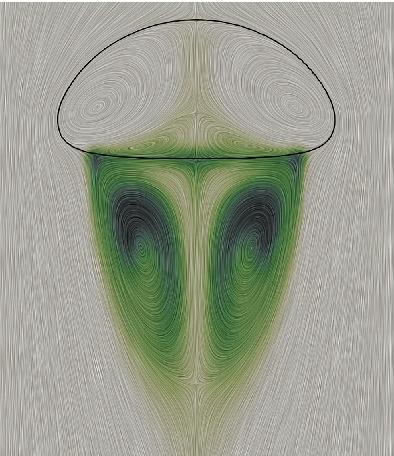当前位置:
X-MOL 学术
›
Int. J. Numer. Methods Fluids
›
论文详情
Our official English website, www.x-mol.net, welcomes your
feedback! (Note: you will need to create a separate account there.)
Basic verification of a numerical framework applied to a morphology adaptive multifield two‐fluid model considering bubble motions
International Journal for Numerical Methods in Fluids ( IF 1.7 ) Pub Date : 2020-08-13 , DOI: 10.1002/fld.4907 Richard Meller 1 , Fabian Schlegel 1 , Dirk Lucas 1
International Journal for Numerical Methods in Fluids ( IF 1.7 ) Pub Date : 2020-08-13 , DOI: 10.1002/fld.4907 Richard Meller 1 , Fabian Schlegel 1 , Dirk Lucas 1
Affiliation

|
A morphology adaptive modeling framework is derived that is able to handle computationally efficiently dispersed as well as resolved interfacial structures coexisting in the computational domain with the same set of equations. The Eulerian multifield two‐fluid model is combined with the compact momentum interpolation method for multiple phases, which has been proposed in the literature as an extension to the Rhie‐Chow pressure‐velocity coupling. Additionally to the interfacial drag force, the virtual mass force is consistently accounted for in the model. Utilizing a specialized interfacial drag formulation, large interfacial structures can be described with the presented method in a volume‐of‐fluid‐like manner, additionally to the disperse description. The strong phase coupling due to the drag closure model in interfacial regions is resolved with a partial elimination algorithm, which is adapted to work in an approximate manner for more than two phases via a sum formulation. The presented model is implemented in the C++ library OpenFOAM and solver performance is compared with results obtained with the homogeneous model approach in two cases of a single rising gas bubble for two‐ and three‐dimensional space, respectively. Additionally, for both three‐dimensional cases, the results are compared with experimental data. Finally, the presented method's capability of representing dispersed and resolved interfacial structures at the same time is demonstrated with two test cases: a two‐dimensional gas bubble, rising in a liquid, which is laden with micro gas bubbles, and a two‐dimensional stagnant stratification of water and oil, sharing a large‐scale interface, which is penetrated by micro gas bubbles.
中文翻译:

考虑气泡运动的形态学自适应多场双流体模型数值框架的基础验证
派生了一种形态学自适应建模框架,该框架能够处理在计算域中使用同一组方程组共存的有效计算分散和已解析界面结构。欧拉多场双流体模型与紧凑的动量插值方法相结合,用于多相,这在文献中已被提出作为Rhie-Chow压力-速度耦合的扩展。除了界面阻力外,模型中还始终考虑了虚拟质量力。利用专门的界面阻力配方,除了分散描述外,还可以使用本方法以大体积流体的方式描述大型界面结构。通过局部消除算法解决了由于界面区域中的阻滞闭合模型而引起的强相耦合,该算法适用于通过求和公式以近似方式对两个以上的相进行工作。呈现的模型在C ++库中实现将OpenFOAM和求解器的性能分别与在二维空间和三维空间中单个上升气泡的两种情况下的均质模型方法获得的结果进行比较。此外,对于这两种三维情况,将结果与实验数据进行比较。最后,通过两个测试案例证明了该方法同时表示分散和分辨的界面结构的能力:一个二维气泡,在液体中上升,充满微气泡;以及一个二维停滞水和油分层,共有一个大界面,微气泡穿透了该界面。
更新日期:2020-08-13
中文翻译:

考虑气泡运动的形态学自适应多场双流体模型数值框架的基础验证
派生了一种形态学自适应建模框架,该框架能够处理在计算域中使用同一组方程组共存的有效计算分散和已解析界面结构。欧拉多场双流体模型与紧凑的动量插值方法相结合,用于多相,这在文献中已被提出作为Rhie-Chow压力-速度耦合的扩展。除了界面阻力外,模型中还始终考虑了虚拟质量力。利用专门的界面阻力配方,除了分散描述外,还可以使用本方法以大体积流体的方式描述大型界面结构。通过局部消除算法解决了由于界面区域中的阻滞闭合模型而引起的强相耦合,该算法适用于通过求和公式以近似方式对两个以上的相进行工作。呈现的模型在C ++库中实现将OpenFOAM和求解器的性能分别与在二维空间和三维空间中单个上升气泡的两种情况下的均质模型方法获得的结果进行比较。此外,对于这两种三维情况,将结果与实验数据进行比较。最后,通过两个测试案例证明了该方法同时表示分散和分辨的界面结构的能力:一个二维气泡,在液体中上升,充满微气泡;以及一个二维停滞水和油分层,共有一个大界面,微气泡穿透了该界面。











































 京公网安备 11010802027423号
京公网安备 11010802027423号